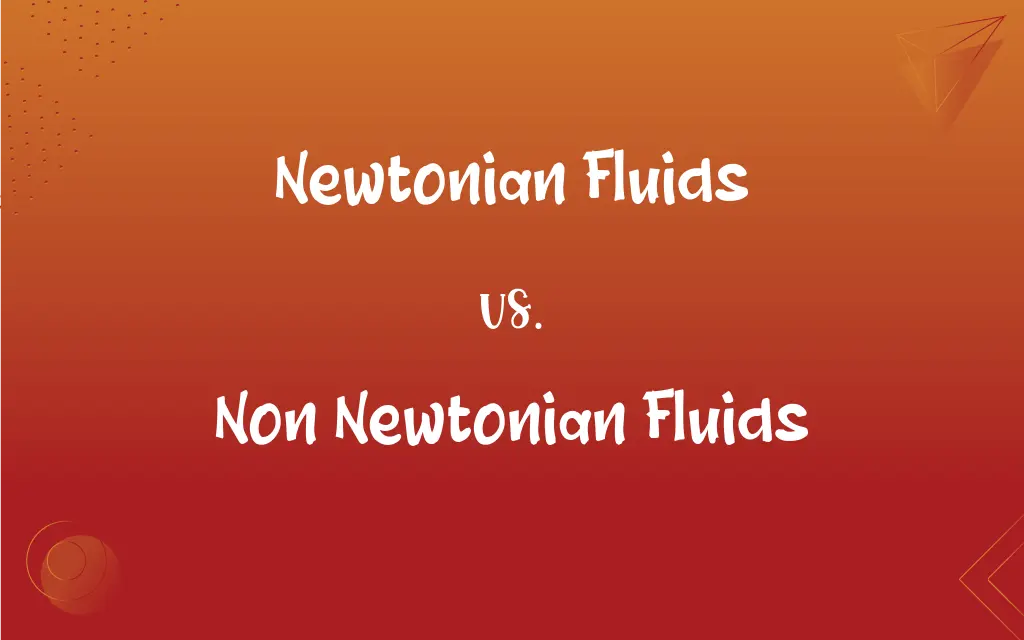Newtonian Fluids vs. Non Newtonian Fluids: What's the Difference?
Edited by Aimie Carlson || By Harlon Moss || Published on March 22, 2024
Newtonian fluids have a constant viscosity regardless of applied stress, while non-Newtonian fluids have a viscosity that changes with applied stress or strain rate.

Key Differences
Newtonian fluids exhibit a constant viscosity regardless of the shear rate or applied stress. This means their flow behavior does not change under force. Non-Newtonian fluids, in contrast, have a viscosity that changes when stress or strain rate is applied, resulting in altered flow characteristics.
Common examples of Newtonian fluids include water, air, and most oils, which behave consistently under different conditions. Non-Newtonian fluids include substances like ketchup, custard, and cornstarch mixed with water, which behave unpredictably and change their flow properties under stress.
Newtonian fluids flow the same way regardless of how they are handled or stirred. Non-Newtonian fluids can become either more liquid or more solid in response to force; some thicken when stirred (shear thickening), while others become thinner (shear thinning).
In scientific and industrial contexts, understanding the behavior of Newtonian fluids allows for straightforward calculations regarding flow and pressure. Non-Newtonian fluids require more complex analysis due to their variable behavior, impacting industries from food processing to material science.
The flow of Newtonian fluids is described by a linear relationship between shear stress and shear rate, typically modeled by Newton's law of viscosity. Non-Newtonian fluids, however, do not follow this linear relationship and often require more complex models to describe their flow behavior.
ADVERTISEMENT
Comparison Chart
Viscosity Under Stress
Constant viscosity
Variable viscosity depending on stress
Common Examples
Water, air, mineral oil
Ketchup, custard, oobleck
Response to Force
Unchanged flow properties
Flow properties change (thicken or thin)
Industrial Application
Predictable flow, easier calculations
Complex behavior, specialized applications
Mathematical Modeling
Linear relationship (Newton's law)
Non-linear, complex models required
ADVERTISEMENT
Newtonian Fluids and Non Newtonian Fluids Definitions
Newtonian Fluids
Fluids whose flow behavior conforms to Newton's law of viscosity.
Air, another Newtonian fluid, maintains its properties under standard conditions.
Non Newtonian Fluids
Fluids that can behave both as solid and liquid under different conditions.
Oobleck, a non-Newtonian fluid, acts like a solid when hit and liquid when held gently.
Newtonian Fluids
Fluids with a constant viscosity at different shear rates.
Water, a Newtonian fluid, flows consistently regardless of how fast it's poured.
Non Newtonian Fluids
Fluids where shear stress is not proportional to shear rate.
Silicone polymers, as non-Newtonian fluids, exhibit complex flow behaviors.
Newtonian Fluids
Fluids with predictable flow characteristics under stress.
Mineral oil, as a Newtonian fluid, is used in machines due to its consistent viscosity.
Non Newtonian Fluids
Fluids whose viscosity changes under stress or shear rate.
Cornstarch and water mixture thickens under pressure, showing its non-Newtonian nature.
Newtonian Fluids
Fluids where shear stress is directly proportional to shear rate.
Glycerin, a Newtonian fluid, has a linear relationship between shear stress and rate.
Non Newtonian Fluids
Liquids with unpredictable flow behavior under force.
Custard, due to its non-Newtonian properties, changes consistency with the applied force.
Newtonian Fluids
Liquids that do not change viscosity with varying force.
The hydraulic fluid, being Newtonian, ensures steady operation of the equipment.
Non Newtonian Fluids
Fluids not following Newton's law of viscosity.
Ketchup becomes thinner when shaken, a characteristic of non-Newtonian fluids.
FAQs
Do non-Newtonian fluids always become thicker under stress?
No, some become thinner (shear thinning), while others become thicker (shear thickening).
Can a fluid be both Newtonian and non-Newtonian?
No, a fluid is either Newtonian or non-Newtonian based on its viscosity behavior.
What defines a Newtonian fluid?
A Newtonian fluid has a constant viscosity at different shear rates.
What is a non-Newtonian fluid?
A non-Newtonian fluid changes its viscosity under stress or shear rate.
What is an example of a Newtonian fluid?
Water is a classic example of a Newtonian fluid.
Are gases Newtonian?
Yes, most gases are considered Newtonian fluids.
Can the viscosity of Newtonian fluids change with temperature?
Yes, while constant under stress, their viscosity can change with temperature.
Are Newtonian fluids used in industrial applications?
Yes, their predictable behavior makes them suitable for many industrial applications.
Is honey a non-Newtonian fluid?
Yes, honey is a non-Newtonian fluid as its viscosity changes under stress.
How does temperature affect non-Newtonian fluids?
Like Newtonian fluids, their viscosity can also change with temperature.
Is blood a Newtonian or non-Newtonian fluid?
Blood is a non-Newtonian fluid due to its complex composition.
How do you test if a fluid is Newtonian?
By measuring if its viscosity remains constant under different shear rates.
Can non-Newtonian fluids revert to their original state?
Yes, their viscosity can revert when the stress is removed.
How do non-Newtonian fluids benefit material science?
They offer unique properties useful for developing smart materials and composites.
Are all oils Newtonian fluids?
Most oils are Newtonian, but some complex oils can exhibit non-Newtonian behavior.
How are Newtonian fluids modeled in physics?
They are modeled using Newton's law of viscosity, with a linear shear stress-shear rate relationship.
What are the practical uses of non-Newtonian fluids?
They are used in various applications, from food processing to impact-resistant materials.
Why is understanding Newtonian fluids important in engineering?
It's crucial for designing systems involving fluid flow, like pipelines and hydraulics.
Are non-Newtonian fluids common in nature?
Yes, many biological fluids are non-Newtonian.
What makes non-Newtonian fluids challenging to model?
Their non-linear stress-strain behavior makes modeling complex.
About Author
Written by
Harlon MossHarlon is a seasoned quality moderator and accomplished content writer for Difference Wiki. An alumnus of the prestigious University of California, he earned his degree in Computer Science. Leveraging his academic background, Harlon brings a meticulous and informed perspective to his work, ensuring content accuracy and excellence.
Edited by
Aimie CarlsonAimie Carlson, holding a master's degree in English literature, is a fervent English language enthusiast. She lends her writing talents to Difference Wiki, a prominent website that specializes in comparisons, offering readers insightful analyses that both captivate and inform.































































